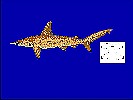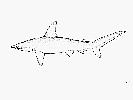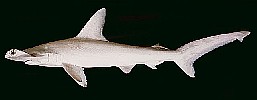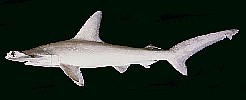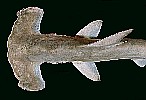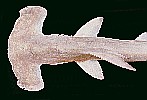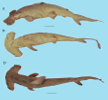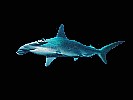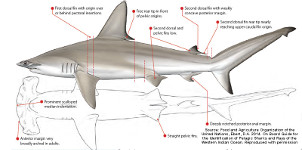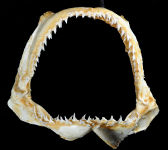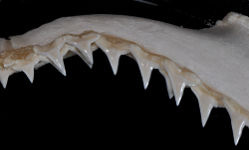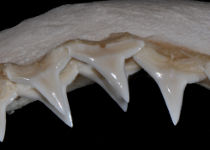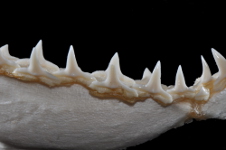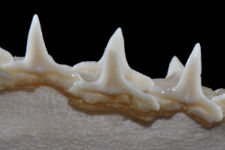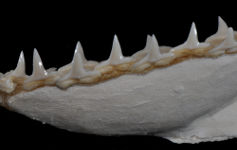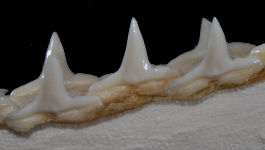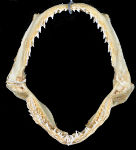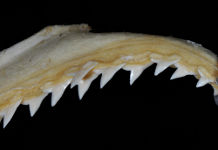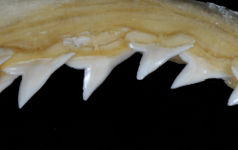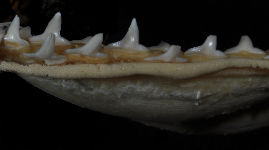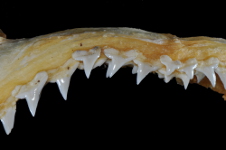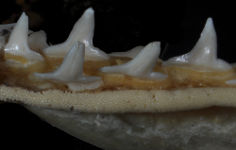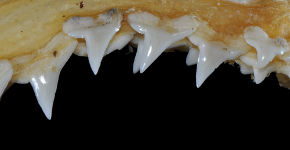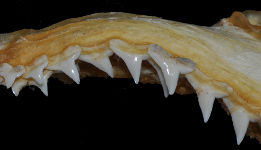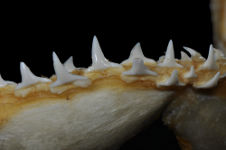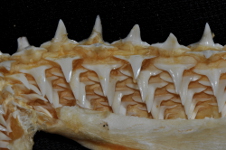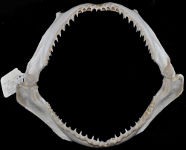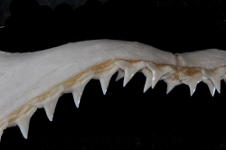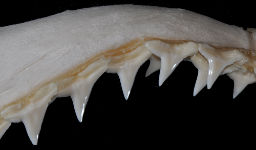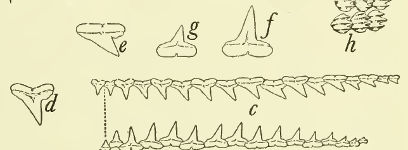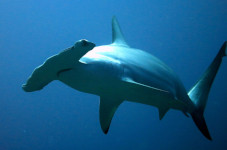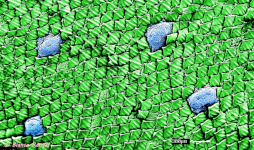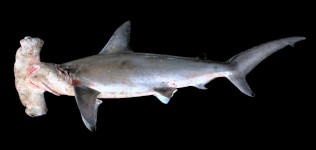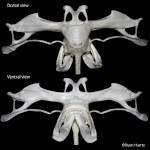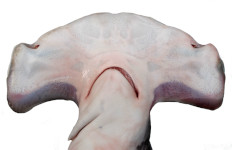Sphyrna lewini
(Griffith & Smith, 1834)
Scalloped hammerhead
Classification: Elasmobranchii Carcharhiniformes Sphyrnidae
Reference of the original description
The class Pisces, arranged by the Baron Cuvier, with supplementary additions, by Edward Griffith, F.R.S. &c. and Lieut.-Col. Charles Hamilton Smith, F.R., L.S.S. &c. &c. The animal kingdom. London. Vol. 1, 1–680 pp, 62 pls
The class Pisces, arranged by the Baron Cuvier, with supplementary additions, by Edward Griffith, F.R.S. &c. and Lieut.-Col. Charles Hamilton Smith, F.R., L.S.S. &c. &c. The animal kingdom. London. Vol. 1, 1–680 pp, 62 pls
Image of the original description
.jpg)
Zygaena lewini in Cuvier, 1834 (valid name: Sphyrna lewini)
.jpg)
Zygaena lewini in Cuvier, 1834 (valid name: Sphyrna lewini)
Synonyms / new combinations and misspellings
Cestracion lewini, Cestracion oceanica, Cestracion (Zygaena) leeuwenii, Sphyrna aff. lewini, Sphyrna cf. lewini, Sphyrna couardi, Sphyrna diplana, Sphyrna leweni, Sphyrna lewinii, Sphyrna (Sphyrna) couardi, Sphyrna (Sphyrna) lewini, Zygaena erythraea, Zygaena indica, Zygaena leeuwenii, Zygaena lewini
Cestracion lewini, Cestracion oceanica, Cestracion (Zygaena) leeuwenii, Sphyrna aff. lewini, Sphyrna cf. lewini, Sphyrna couardi, Sphyrna diplana, Sphyrna leweni, Sphyrna lewinii, Sphyrna (Sphyrna) couardi, Sphyrna (Sphyrna) lewini, Zygaena erythraea, Zygaena indica, Zygaena leeuwenii, Zygaena lewini
Types
Sphyrna lewini
XXXX: No types known;
Cestracion oceanica
Syntype: MCZ: MCZ 460-S USNM: 153587 (ex MCZ 460);
Sphyrna couardi
XXXX: No types known;
Sphyrna diplana
Holotype: USNM: 108451; Paratype: USNM: 110296; USNM: 110297; USNM: 108452;
Zygaena erythraea
Holotype: MB: ? 7814
Zygaena indica
XXXX: No types known;
Sphyrna lewini
XXXX: No types known;
Cestracion oceanica
Syntype: MCZ: MCZ 460-S USNM: 153587 (ex MCZ 460);
Sphyrna couardi
XXXX: No types known;
Sphyrna diplana
Holotype: USNM: 108451; Paratype: USNM: 110296; USNM: 110297; USNM: 108452;
Zygaena erythraea
Holotype: MB: ? 7814
Zygaena indica
XXXX: No types known;
Description :
Citation: Sphyrna lewini (Griffith & Smith, 1834): In: Database of modern sharks, rays and chimaeras, www.shark-references.com, World Wide Web electronic publication, Version 10/2025
Please send your images of "Sphyrna lewini" to info@shark-references.com
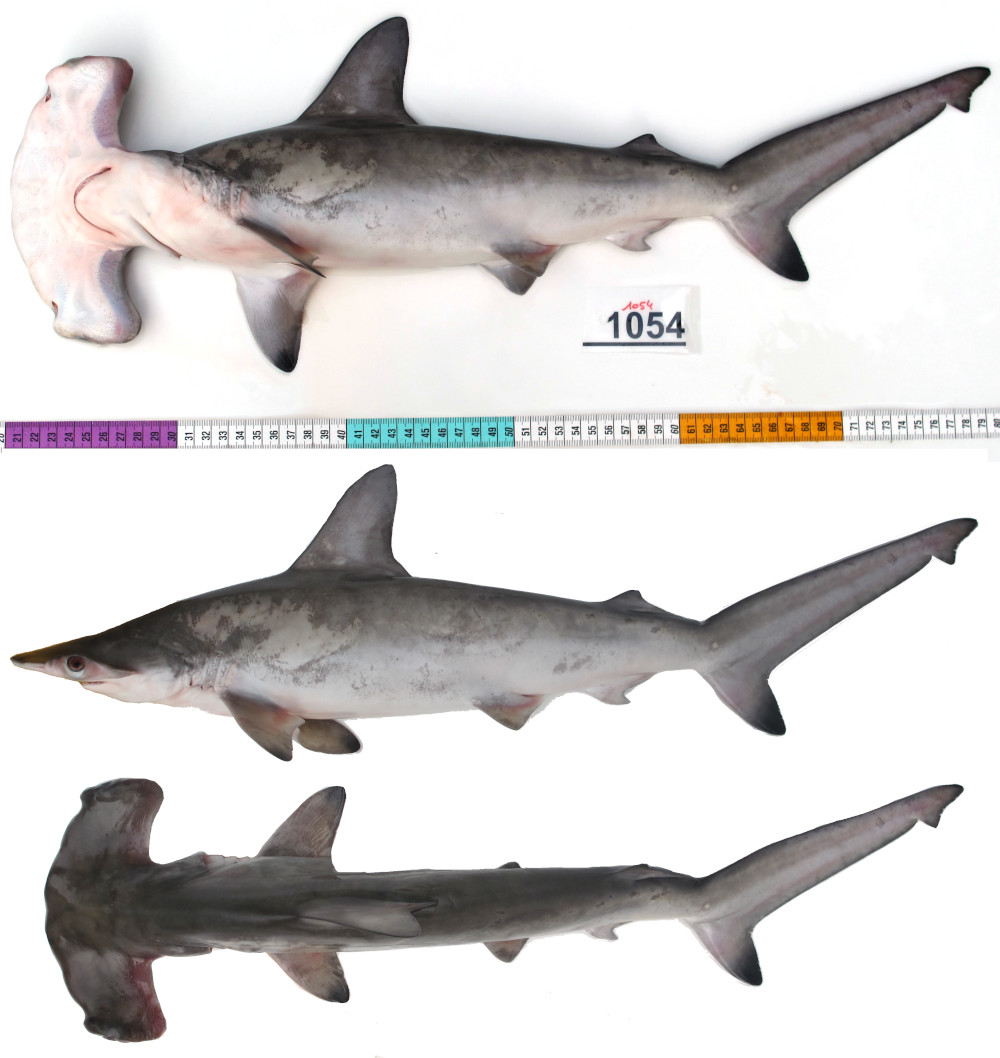
Sphyrna lewini (Griffith & Smith, 1834), ERB 1054, female, 61, 9 cm TL, Australia © Frederik H. Mollen (Elasmobranch Research Belgium)

Sphyrna lewini (Griffith & Smith, 1834), ERB 1054, female, 61, 9 cm TL, Australia © Frederik H. Mollen (Elasmobranch Research Belgium)
Common names
 Cachona,
Cachona,  Cornuda,
Cornuda,  Cornuda comun,
Cornuda comun,  Cornuda martillo,
Cornuda martillo,  Cornuda negra,
Cornuda negra,  Cornúa,
Cornúa,  Morfillo,
Morfillo,  Pez martillo,
Pez martillo,  Tiburón martillo,
Tiburón martillo,  Tiburón martillo festoneado,
Tiburón martillo festoneado,  Requin marteau,
Requin marteau,  Requin marteau halicorne,
Requin marteau halicorne,  Requin-marteau halicorne,
Requin-marteau halicorne,  Bronze hammerhead shark,
Bronze hammerhead shark,  Hammerhead,
Hammerhead,  Hammerhead shark,
Hammerhead shark,  Kidney-headed shark,
Kidney-headed shark,  Scalloped hamerhead,
Scalloped hamerhead,  Scalloped hammer head,
Scalloped hammer head,  Scalloped hammerhead,
Scalloped hammerhead,  Scalloped hammerhead shark,
Scalloped hammerhead shark,  Southern hammerhead shark,
Southern hammerhead shark,  gebuchteter Hammerhai,
gebuchteter Hammerhai,  Squalo martello smerlato,
Squalo martello smerlato,  Cambeva,
Cambeva,  Cambeva preta,
Cambeva preta,  Cação-cornudo,
Cação-cornudo,  Cação-martelo,
Cação-martelo,  Cação-rudela,
Cação-rudela,  Cornudo,
Cornudo,  Peixe-martelo,
Peixe-martelo,  Rudela,
Rudela,  Tubarão martelo comum,
Tubarão martelo comum,  Tubarão-martelo,
Tubarão-martelo,  Tubarão-martelo-recortado,
Tubarão-martelo-recortado,  Tubarão-mona
Tubarão-mona
 Cachona,
Cachona,  Cornuda,
Cornuda,  Cornuda comun,
Cornuda comun,  Cornuda martillo,
Cornuda martillo,  Cornuda negra,
Cornuda negra,  Cornúa,
Cornúa,  Morfillo,
Morfillo,  Pez martillo,
Pez martillo,  Tiburón martillo,
Tiburón martillo,  Tiburón martillo festoneado,
Tiburón martillo festoneado,  Requin marteau,
Requin marteau,  Requin marteau halicorne,
Requin marteau halicorne,  Requin-marteau halicorne,
Requin-marteau halicorne,  Bronze hammerhead shark,
Bronze hammerhead shark,  Hammerhead,
Hammerhead,  Hammerhead shark,
Hammerhead shark,  Kidney-headed shark,
Kidney-headed shark,  Scalloped hamerhead,
Scalloped hamerhead,  Scalloped hammer head,
Scalloped hammer head,  Scalloped hammerhead,
Scalloped hammerhead,  Scalloped hammerhead shark,
Scalloped hammerhead shark,  Southern hammerhead shark,
Southern hammerhead shark,  gebuchteter Hammerhai,
gebuchteter Hammerhai,  Squalo martello smerlato,
Squalo martello smerlato,  Cambeva,
Cambeva,  Cambeva preta,
Cambeva preta,  Cação-cornudo,
Cação-cornudo,  Cação-martelo,
Cação-martelo,  Cação-rudela,
Cação-rudela,  Cornudo,
Cornudo,  Peixe-martelo,
Peixe-martelo,  Rudela,
Rudela,  Tubarão martelo comum,
Tubarão martelo comum,  Tubarão-martelo,
Tubarão-martelo,  Tubarão-martelo-recortado,
Tubarão-martelo-recortado,  Tubarão-mona
Tubarão-mona
Short Description
A large hammerhead with a notch at the center of head; 1st dorsal fin moderately high, 2nd dorsal and pelvic fins low [536]. Front margin of head broadly arched with prominent median notch. Side wings of head narrow, rear margins swept backward [17659]. Uniform grey, grayish brown, or olivaceous above, shading to white below; pectoral fins tipped with grey or black ventrally [20050].
A large hammerhead with a notch at the center of head; 1st dorsal fin moderately high, 2nd dorsal and pelvic fins low [536]. Front margin of head broadly arched with prominent median notch. Side wings of head narrow, rear margins swept backward [17659]. Uniform grey, grayish brown, or olivaceous above, shading to white below; pectoral fins tipped with grey or black ventrally [20050].
Distribution
Circumglobal in coastal warm temperate and tropical seas [20050]. Western Atlantic: New Jersey, USA to Uruguay [5839], including the Gulf of Mexico and Caribbean. Eastern Atlantic: western Mediterranean (Ref. 6678) to Namibia (Ref. 6812). Indo-Pacific: Red Sea, East Africa and throughout the Indian Ocean; Japan to New Caledonia, Hawaii and Tahiti. Eastern Pacific: southern California, USA to Ecuador, probably Peru; Bangladesh (see image in gallery); Source: www.gbif.org
Circumglobal in coastal warm temperate and tropical seas [20050]. Western Atlantic: New Jersey, USA to Uruguay [5839], including the Gulf of Mexico and Caribbean. Eastern Atlantic: western Mediterranean (Ref. 6678) to Namibia (Ref. 6812). Indo-Pacific: Red Sea, East Africa and throughout the Indian Ocean; Japan to New Caledonia, Hawaii and Tahiti. Eastern Pacific: southern California, USA to Ecuador, probably Peru; Bangladesh (see image in gallery); Source: www.gbif.org
Human uses
fisheries: commercial; gamefish: yes
fisheries: commercial; gamefish: yes
Biology
Viviparous, placental [733], with 13-23 in a litter [1388]; 12-41 pups after a gestation period of 9-10 months [2539]. Size at birth 45-50 cm TL [20050]; 39-57 cm TL [2539]. It occurs in all tropical and warm-temperate seas. They sometimes congregate over sea mounts or around offshore islands [17645]. A coastal-pelagic, semi-oceanic shark occurring over continental and insular shelves and adjacent deep water, often approaching close inshore and entering enclosed bays and estuaries [517] [20054] [17640]. Found in inshore and offshore waters to about 275 m depth [17659] [20054] [17640]; has been filmed at a baited camera in 512 m depth (Lis Maclaren, pers. Comm. 2005). Huge schools of small migrating individuals move pole ward in the summer in certain areas [517]. Permanent resident populations also exist [517]. Feeds mainly on teleost fishes, cephalopods and zooplankton (Ref. 568) [1388]; also lobsters, shrimps, crabs [20218], including other sharks and rays (Ref. 37816).
Viviparous, placental [733], with 13-23 in a litter [1388]; 12-41 pups after a gestation period of 9-10 months [2539]. Size at birth 45-50 cm TL [20050]; 39-57 cm TL [2539]. It occurs in all tropical and warm-temperate seas. They sometimes congregate over sea mounts or around offshore islands [17645]. A coastal-pelagic, semi-oceanic shark occurring over continental and insular shelves and adjacent deep water, often approaching close inshore and entering enclosed bays and estuaries [517] [20054] [17640]. Found in inshore and offshore waters to about 275 m depth [17659] [20054] [17640]; has been filmed at a baited camera in 512 m depth (Lis Maclaren, pers. Comm. 2005). Huge schools of small migrating individuals move pole ward in the summer in certain areas [517]. Permanent resident populations also exist [517]. Feeds mainly on teleost fishes, cephalopods and zooplankton (Ref. 568) [1388]; also lobsters, shrimps, crabs [20218], including other sharks and rays (Ref. 37816).
Size / Weight / Age
430 cm TL (male/unsexed; [17659]); max. published weight: 152.4 kg (Ref. 40637); max. reported age: 35 years [2246]
430 cm TL (male/unsexed; [17659]); max. published weight: 152.4 kg (Ref. 40637); max. reported age: 35 years [2246]
Habitat
pelagic-oceanic; oceanodromous [17660]; brackish; marine; depth range 0 - 512 m, usually 0 - 25 m [20084]
pelagic-oceanic; oceanodromous [17660]; brackish; marine; depth range 0 - 512 m, usually 0 - 25 m [20084]
Remarks
shark-references Species-ID=6577; CITES: (see: Protected Species for more details) Convention on International Trade in Endangered Speciesof Wild Fauna and Flora annex: II; Council Regulation 2017/160 annex: B
shark-references Species-ID=6577; CITES: (see: Protected Species for more details) Convention on International Trade in Endangered Speciesof Wild Fauna and Flora annex: II; Council Regulation 2017/160 annex: B
Parasites (arranged by Jürgen Pollerspöck)
Myxosporea
Monogenea
Cestoda
Trematoda
Nematoda
Acanthocephala
Copepoda
Isopoda
Myxosporea
- Chloromyxum regularis Lisnerova, Martinek, Alama-Bermejo, Bouberlova, Schaeffner, Nkabi, Holzer & Bartosova-Sojkova, 2022 [31228]
Monogenea
- Erpocotyle microstoma (Brooks, 1934) Yamaguti, 1963 [31265]
- Erpocotyle sphyrnae (Maccallum, 1931) [31265]
- Loimosina parawilsoni Bravo-Hollis, 1970 [23771] [26032]
- Loimosina wilsoni Manter, 1944 [17148] [31265]
Cestoda
- Callitetrarhynchus gracilis (Rudolphi, 1819) Pintner, 1931 [17852] [16112]
- Dasyrhynchus pacificus Robinson, 1965 [5977] [16112]
- Diplootobothrium springeri Chandler, 1942 [16112]
- Doliobothrium sp. [25840]
- Heteronybelinia nipponica (Yamaguti, 1952) [17922] [16112] [25154]
- Heteronybelinia yamagutii (Dollfus, 1960) [16366] [16112] [27172]
- Mixonybelinia edwinlintoni (Dollfus, 1960) [17926] [17845] [16112]
- Mixonybelinia lepturi Palm, 2004 [16112]
- Nybelinia bilobata Palm, 2004 [16112]
- Nybelinia gopalai Chandra & Hanumantha Rao, 1985 [16112]
- Nybelinia goreensis Dollfus, 1960 [17926] [16112]
- Nybelinia sp. [16112]
- Nybelinia sphyrnae Yamaguti, 1952 [15747] [21816] [32432] [32432]
- Otobothrium carcharidis (Shipley & Hornell, 1906) [24083] [21816]
- Otobothrium penetrans Linton, 1907 [9638] [16112] [17826]
- Paraorygmatobothrium sp. [25840]
- Platybothrium tantulum Healy, 2003 [7384] [23771]
- Reimeriella mexicoensis Palm, Morales-Avila, Galvan-Magana & Haseli, 2020 [28319]
- Ruhnkebothrium bajaense Caira, Bueno & Jensen, 2021 [30556]
- Ruhnkebothrium mattisi Caira, Bueno & Jensen, 2021 [30556]
- Sphyrnacestus ananas Caira, Bueno & Jensen, 2025 [35028]
- Sphyrnacestus latocapitus Caira, Bueno & Jensen, 2025 [35028]
- Sphyrnacestus lewinensis (Caira, Richmond & Swanson, 2005) Caira, Bueno & Jensen, 2025 [16205]
- Symbothriorhynchus tigaminacantha Palm, 2004 [17827] [21718]
Trematoda
- Multicalyx cristata Faust & Tang, 1936 [25760] [27172]
- Staphylorchis cymatodes (Johnston, 1913) [11242]
Nematoda
- Euterranova galeocerdonis (Thwaite, 1927) [17029]
- Neoomeia sphyna Yin & Zhang, 1984 [21235]
- Parascarophis sphyrnae Campana-Rouget, 1955 [27694]
- Piscicapillaria bursata Moravec & Barton, 2019 [27694] [28580]
- Pulchrascaris australis Shamsi, Barton & Zhu, 2020 [28522]
- Pulchrascaris chiloscyllii (Johnston & Mawson, 1951) [17029]
Acanthocephala
- Serrasentis sagittifer (Linton, 1889) [27561]
Copepoda
- Alebion carchariae Krøyer, 1863 [16589] [17000] [26820]
- Alebion crassus (Bere, 1936) [14785] [17000] [26820]
- Alebion elegans Capart, 1953 [16589]
- Echthrogaleus denticulatus Smith, 1873 [19355] [19356]
- Eudactylina aspera Heller, 1865 [16583] [17867] [15303] [15305] [27172]
- Eudactylina pollex Cressey, 1967 [16589]
- Kroeyerina scottorum Cressey, 1972 [16589] [15948] [15305] [27172]
- Kroyeria spatulata Pearse, 1948 [15303]
- Kroyeria sphyrnae Rangnekar, 1957 [14785] [17867] [15301] [22489] [27172] [34815]
- Nemesis lamna Risso, 1826 [21355]
- Nemesis robusta (Van Beneden, 1851) [16583] [15303]
- Nemesis sp. [27172]
- Nesippus crypturus Heller, 1868 [16599] [16583] [14785] [16589] [15303]
- Nesippus orientalis Heller, 1868 [16583] [15303] [15304] [15284] [27172]
- Nogagus borealis (Steenstrup & Lütken, 1861) [17000]
- Pandarus cranchii Leach, 1819 [17000] [33255]
- Pandarus niger Kirtisinghe, 1950 [16569]
- Pandarus smithii Rathbun, 1886 [33255]
- Pandarus sp. [27172]
- Pannosus japonicus (Shiino, 1960) [15305] [27172]
- Perissopus dentatus Steenstrup & Lütken, 1861 [16569]
- Pseudopandarus australis Cressey & Simpfendorfer, 1988 [16579] [16569] [25052]
- Tripaphylus vaissierei (Delamare-Deboutteville & Nunes- Ruivo, 1954) [14785] [15305] [25960] [27172]
Isopoda








